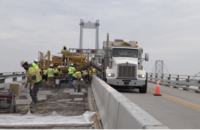The city of Chesapeake, Va., has had to toil hard and manage creatively to get its long-planned Dominion Boulevard improvement project off the ground—literally and figuratively. The $345-million project features nine bridges, including a new dual-span crossing over the Elizabeth River, set on unpredictable soil strata that required extensive measures to expedite soil settlement and make it more stable.
City and project team officials also used innovative management and financing to move the project forward. The project aims to ease traffic on the congested corridor between the city and the North Carolina border. Plans called for replacing the existing two-lane bascule drawbridge, which opened an average of 16 times a day for roughly 10 minutes at a time. The new spans reach a maximum height of 95 ft above the river, allowing vehicular and marine traffic to flow freely.
In 1990, about 18,000 vehicles crossed the river daily. By the time the project broke ground in January 2013, the daily average had risen to 33,000. By 2030, the city estimates traffic could increase to 42,000 vehicles a day. That forecast prompted the Hampton Roads Transportation Planning Organization to rank the Dominion Boulevard project as one of the most promising for reducing traffic congestion.
Despite the pressing need, a lack of sufficient funding hampered efforts to get the project moving. “We tried traditional methods, but there was never enough money available—not through local budgets nor through the [Virginia DOT] six-year plan,” recalls Kevin Lundgren, project manager with the Chesapeake Dept. of Public Works.
The city chose to find its own solution and pursued the improvements as a VDOT locally administered project, in which local governments manage their projects with oversight from VDOT. With the state agency’s approval, Dominion Boulevard became the largest VDOT locally administered project in state history.
In another pioneering step, the city received a $151.9-million loan through the Virginia Transportation Infrastructure Bank—the bank’s first loan. When the crossing opens in early 2017, it will have electronic tolling, which will enable the city to secure $158.5 million in toll-revenue bonds. State and federal funds cover the rest of the cost.
The project’s design, led by WSP | Parsons Brinckerhoff’s Virginia Beach office, centers on the two concrete post-tensioned spans—a 5,982-ft-long, two-lane northern span and a 5,262-ft-long southern span. Including the seven bridges on shore, the team will construct nearly 13,000 linear ft of new bridges.
To build the project, the city selected Dominion Boulevard Contractors, a joint venture of McLean Contracting, Chesapeake; E.V. Williams, Virginia Beach; Bryant Contracting, Toano, Va.; and R.R. Dawson Bridge Co., Powhatan, Va.
Because the team is a line-item JV, each contractor has a specified scope, with McLean, Bryant and R.R. Dawson dividing work on the bridges. McLean’s scope includes construction and demolition over the river. Bryant is building onshore bridges. R.R. Dawson is focused on the decks. E.V. Williams is building roadways, approaches and related infrastructure. MBP, Chesapeake, is providing construction, engineering and inspection services for the city.
Although Chesapeake already had some right-of-way that it purchased in the 1960s, the site was still squeezed by new development in the area. “This job is very vertical,” says Del Baker, E.V. Williams senior project manager. “Because of the narrow footprint, you had to go vertical quickly. You couldn’t go horizontal because of right-of-way restrictions.”
That design decision necessitated a high volume of mechanically stabilized earth walls (MSE), Baker says. When the project is complete, about 10,000 linear ft of MSE wall will have been built.
Early in the project, the team learned that soils would pose a significant challenge. “There were very poor soil conditions—not just for the bridges but also the earthwork embankments,” says Mike Prezioso, MBP senior vice president. “The predicted settlement in the soils was greater than you could build to in a timely fashion. We had predicted settlements of 1 to 2 feet on some embankments and that would have taken months, so we had to accelerate that process with surcharges.”
A combination of ground improvement piles and wick drains were also used. In all, the project required 5 million vertical ft of wick drains and more than 600 ground improvement piles.
While working in the river, McLean Contracting also contended with inconsistent strata. “On the north span, there are two piers in the river, and we found totally different pile-driving conditions on one side compared to the other,” says Joe Hoffman, McLean project manager.
Hoffman adds, “One side we drove to plan with no issues at all. The other side, we couldn’t get the test piles down. We ended up having to cast piles with points on them and do some augering. On one side, we drove roughly 90-ft piles with no issue and on the other side we drove 70-ft piles with points and augering to get them that far.”
The project used lots of concrete. For example, nearly 2,500 12-in.-dia precast concrete piles and 2,500 30-in.-dia piles were driven. If they were laid end to end, the piles would stretch about 28 miles, according to the team.
Moreover, the nine bridges require approximately 600 precast concrete girders, including 285-ft girders on the river spans. An additional 65,000 cu yd of cast-in-place concrete will be used. Lundgren says cost was a significant factor in deciding to use so much concrete. There are three batch plants—including one on site—within 10 miles of the project, making deliveries affordable and reliable.
Lundgren says that although VDOT is moving away from epoxy-coated steel in favor of stainless steel, the team was allowed to specify corrosion-resistant steel. “We’ll get the same longevity and save some money,” he says. “That decision saved us $7 million.”
In another cost-saving move, the team used a portion of its right-of-way for wetland mitigation. As part of the project, six permanent stormwater management basins were added to improve runoff quality and increase available retention volume.
The site did offer some advantages. McLean was able to demolish the existing bascule bridge, remove large sections and ship them out by barge. For demolition, McLean used a high-capacity floating crane. Crews opened the twin-leaf bascules and blocked the counterweight in the pit. Rigging was hooked to the leaf’s steel portion, which was torched off and removed.
That left the counterweight hanging in the pit. Crews cut it into large pieces with wire saws. As of early December, work was underway to remove the bascule bridge piers. Crews again were using a wire-saw technique. “A lot of contractors have battled removing [bridges] like these recently, but so far, it’s been successful for us,” Hoffman says.
Although the project must be finished by April 1, 2017, Baker says the team is aiming for a Sept. 22, 2016, completion date. The city’s contract with the joint venture construction team offers a bonus for early completion. The bonus tops out at $5 million if the job is done six months ahead of schedule. “They have been on track to get it done,” Lundgren says. “I may have to write them that check.”









Post a comment to this article
Report Abusive Comment